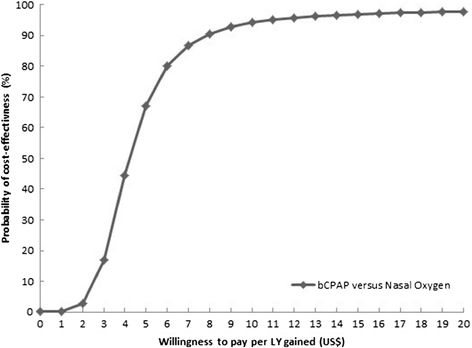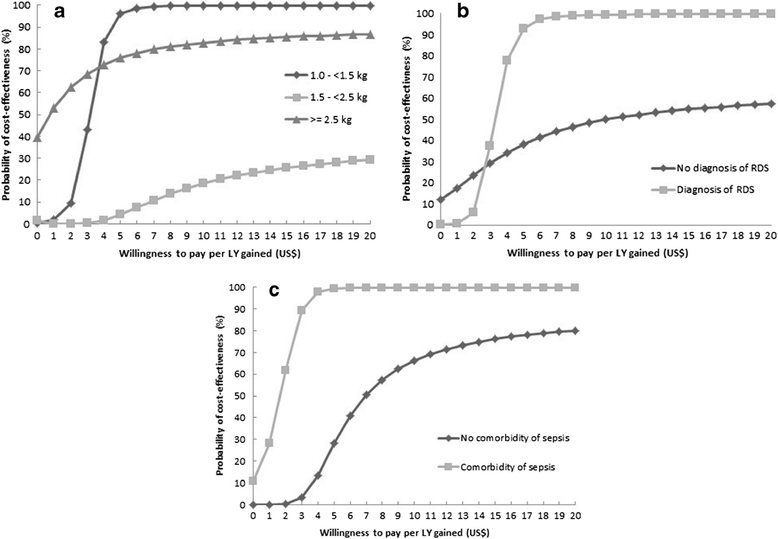Cost-effectiveness analysis of a low-cost bubble CPAP device in providing ventilatory support for neonates in Malawi - a preliminary report
- PMID: 25421903
- PMCID: PMC4247223
- DOI: 10.1186/s12887-014-0288-1
Cost-effectiveness analysis of a low-cost bubble CPAP device in providing ventilatory support for neonates in Malawi - a preliminary report
Abstract
Background: A low-cost bubble continuous positive airway pressure (bCPAP) device has been shown to be an excellent clinical alternative to nasal oxygen for the care of neonates with respiratory difficulty. However, the delivery of bCPAP requires more resources than the current routine care using nasal oxygen. We performed an economic evaluation to determine the cost-effectiveness of a low-cost bCPAP device in providing ventilatory support for neonates in Malawi.
Methods: We used patient-level clinical data from a previously published non-randomized controlled study. Economic data were based on the purchase price of supplies and equipment, adjusted for shelf life, as well as hospital cost data from the World Health Organization. Costs and benefits were discounted at 3%. The outcomes were measured in terms of cost, discounted life expectancy, cost/life year gained and net benefits of using bCPAP or nasal oxygen. The incremental cost-effectiveness ratio and incremental net benefits determined the value of one intervention compared to the other. Subgroup analysis on several parameters (birth weight categories, diagnosis of respiratory distress syndrome, and comorbidity of sepsis) was conducted to evaluate the effect of these parameters on the cost-effectiveness.
Results: Nasal oxygen therapy was less costly (US$29.29) than the low-cost bCPAP device ($57.78). Incremental effectiveness associated with bCPAP was 6.78 life years (LYs). In the base case analysis, the incremental cost-effectiveness ratio for bCPAP relative to nasal oxygen therapy was determined to be $4.20 (95% confidence interval, US$2.29-US$16.67) per LY gained. The results were highly sensitive for all tested subgroups, particularly for neonates with birth weight 1- < 1.5 kg, respiratory distress syndrome, or comorbidity of sepsis; these subgroups had a higher probability that bCPAP would be cost effective.
Conclusion: The bCPAP is a highly cost-effective strategy in providing ventilatory support for neonates in Malawi.
Figures
References
-
- Oestergaard MZ, Inoue M, Yoshida S, Mahanani WR, Gore FM, Cousens S, Lawn JE, Mathers CD, United Nations Inter-Agency Group for Child Mortality E, the Child Health Epidemiology Reference G Neonatal mortality levels for 193 countries in 2009 with trends since 1990: a systematic analysis of progress, projections, and priorities. PLoS Med. 2011;8(8):e1001080. doi: 10.1371/journal.pmed.1001080. - DOI - PMC - PubMed
-
- March of Dimes, PMNCH, Save the Children, WHO: Born Too Soon: The Global Action Report on Preterm Birth. In Edited by Howson CP, Kinney MV, Lawn JE. Geneva: World Health Organization; 2012.
-
- You D, New RJ, Wardlaw T. Levels and Trends in Child Mortality: Estimates Developed by the UN Inter-Agency Group for Child Mortality Estimation. New York: UNICEF; 2012.
Publication types
MeSH terms
Grants and funding
LinkOut - more resources
Full Text Sources
Other Literature Sources
Medical



